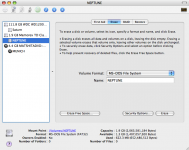- Joined
- Apr 29, 2006
- Messages
- 4,576
- Reaction score
- 378
- Points
- 83
- Location
- St. Somewhere
- Your Mac's Specs
- Mac Studio, M1 Max, 32 GB RAM, 2 TB SSD
This morning I decided to backup my work PC (Windows), which I haven't done for a long time. I took out my trusty old Buslink 80 GB USB2.0 drive and plugged it into my PC, totally forgetting that I had reformatted that drive to HFS+ (the Mac disk format). Windows beeped at me, indicating that it recognized that I had plugged something in (Windows is SO helpful, isn't it? <grin>) but that was all. The drive didn't show up in My Computer, nor anywhere else except the Safely Eject Hardware item in the system tray.
After a moment of head scratching, I realized what had to be wrong and plugged the drive into my Mac, thinking to reformat it to FAT32 on the Mac, which is MUCH more helpful generally. The drive immediately showed up on my desktop (thank you Apple!). I ejected it, started Disk Utility and selected Erase. To my great surprise, there was no option for FAT32, Windows, or any other formats except variations of HFS and Unix format. Not so helpful after all!
A little Googling later, I came up on this gem, which details the Terminal comands needed to reformat a disk with FAT32. This has worked like a champ, and I thought I would pass it on to this community, lest it help anyone else wondering about this problem.
http://www.macosxhints.com/article.php?story=20030613121738812
A bit obscure, but it worked very well. I find it ironic that I had to use my Mac to format a drive for use in Windows - Windows wouldn't allow me to accomplish this feat by itself! Windows is SO helpful, isn't it? :dummy:
The magic command, lest the above URL should disappear in the future:
In Terminal, type:
newfs_msdos -V volume_name -F 32 /dev/rdisk2
Note that this command may take a minute or two to execute, and provides no feedback while it is doing it's job. That last name (/dev/rdisk2) can be determined by issuing the command:
ls /dev/rdisk?
before and after plugging in the drive. You will see an additional entry in the listing after you have plugged the drive in vs. before. That new entry is the name to use in the newfs_msdos command.
After a moment of head scratching, I realized what had to be wrong and plugged the drive into my Mac, thinking to reformat it to FAT32 on the Mac, which is MUCH more helpful generally. The drive immediately showed up on my desktop (thank you Apple!). I ejected it, started Disk Utility and selected Erase. To my great surprise, there was no option for FAT32, Windows, or any other formats except variations of HFS and Unix format. Not so helpful after all!
A little Googling later, I came up on this gem, which details the Terminal comands needed to reformat a disk with FAT32. This has worked like a champ, and I thought I would pass it on to this community, lest it help anyone else wondering about this problem.
http://www.macosxhints.com/article.php?story=20030613121738812
A bit obscure, but it worked very well. I find it ironic that I had to use my Mac to format a drive for use in Windows - Windows wouldn't allow me to accomplish this feat by itself! Windows is SO helpful, isn't it? :dummy:
The magic command, lest the above URL should disappear in the future:
In Terminal, type:
newfs_msdos -V volume_name -F 32 /dev/rdisk2
Note that this command may take a minute or two to execute, and provides no feedback while it is doing it's job. That last name (/dev/rdisk2) can be determined by issuing the command:
ls /dev/rdisk?
before and after plugging in the drive. You will see an additional entry in the listing after you have plugged the drive in vs. before. That new entry is the name to use in the newfs_msdos command.






